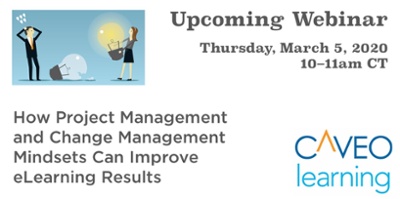Posted by Caveo Learning ● January 23, 2020
Don’t Get Lost: A Roadmap for New Curriculum Design
 Once upon a time, long, long ago…wait…no, this was just last week…I was having a conversation with a client about an emerging need. They were looking for assistance in designing a curriculum to support the learning needs of three roles. They had collected what people were using today and felt they had a pretty good idea of what was needed and wanted to get right to it.
Once upon a time, long, long ago…wait…no, this was just last week…I was having a conversation with a client about an emerging need. They were looking for assistance in designing a curriculum to support the learning needs of three roles. They had collected what people were using today and felt they had a pretty good idea of what was needed and wanted to get right to it.
I had a few questions, including:
- Why is this a need today vs. in the past?
- Is there something about these roles that is changing or has recently changed?
- What performance are you looking for as an outcome of people completing this training?
The answers were familiar. What we hear pretty regularly. There was a business priority involved, new technology being introduced that they hope people adopt, change in process and responsibilities, and a pretty fuzzy picture of the future outcome.
Yep. That’s what I thought…there’s much more to the story.
I continued to inquire for additional details, but the client was pretty set in going forth with building right away. They had their reasons, but the approach carried a lot of risk.
It isn’t just risky for new curriculums or programs either. In other instances, clients may need to re-design curriculum due to age, technology shifts, audience needs, or “it wasn’t working.” Because the client had something already, that temptation to just dive in is often even stronger because they believe they know what was wrong.
It’s an easy trap to fall into because people feel in tune with their organization and may have prior personal experience in the topic or in the role. While this is certainly helpful, it doesn’t generally capture the nuances and points of influence that can take a learning solution from “it checks the box” to “clear success and impact on performance.” And when that effort is linked to a business priority, impacts core audience groups, and is a sizable investment, L&D leaders are not setting themselves up for success with this approach.
So what’s missing? A structure and design that is driven by the true needs of this audience. Further informed by future organizational goals and priorities, performance targets for the business, the makings of best practice for each role, organizational culture, working environment, technology enablers and restrictions, alignment to available resources and stakeholder support for ongoing sustainment, and so on and so on.
Think of it this way: Say you are moving across the country and must arrive at your destination on a particular date, by a particular time. At first, you pop open Google maps and enter your destination. Boom! Route options. Your mind immediately thinks, “Shortest one for the win!”
But wait…this takes you through mountains and some deserted areas. You are driving that moving van, and it doesn’t seem to be the most nimble. Hmmm…maybe a different route is best?
The more you look, the more you realize that there are many logistical details involved in ensuring you arrive safely and on time. Long stretches of road without fuel options? Where to eat? Where to stay overnight with parking for that big a$$ van you are driving? How many miles a day must you travel? Do you want to avoid toll roads in multiple states? Any low bridges to be aware of? On the surface, the task of getting from point A to point B seemed easy. But if you had jumped in the moving van and set off without a bit of planning, you’d have quickly run into issues, extra costs, delays, hunger pangs, and maybe even finding yourself roadside in the desert looking to hitch a ride like Clark Griswold on his way to Wally World.
On the surface, the task of getting from point A to point B seemed easy. But if you had jumped in the moving van and set off without a bit of planning, you’d have quickly run into issues, extra costs, delays, hunger pangs, and maybe even finding yourself roadside in the desert looking to hitch a ride like Clark Griswold on his way to Wally World.
It’s tempting to dive in and go straight to building something, but more often than not, it’s valuable to first slow down so that you can eventually speed up and get the results you are really after.
So…considering this, what’s missing from your plan?
Topics: Instructional Design, Learning Strategy

